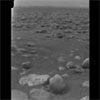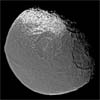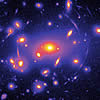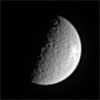Sun-striped Saturn
Jan 31:
In a dazzling and dramatic portrait painted by the Sun, the long thin shadows of Saturn's rings sweep
across the planet's northern latitudes. Within the shadows, bright bands represent areas where the ring
material is less dense, while dark strips and wave patterns reveal areas of denser material.
 FULL STORY FULL STORY
 |  |

|
 |
Giant Saturn's shadow
Jan 31:
Now, in southern summer, Saturn's shadow stretches across the sunlit southern surface of its rings.
Saturn's moon Janus orbits just outside of the main rings and appears below them in this scene. Janus is
absolutely dwarfed by the bulk of its gigantic parent.
 FULL STORY FULL STORY
 |  |

|
 |
Spotlight on Mimas
Jan 31:
Mimas is caught in the spotlight beneath Saturn's rings in this amazing view from Cassini. Notable is the
brightened outermost edge of the A ring beyond the narrow Keeler gap and the periodic brightening of the
thin, knotted F ring.
 FULL STORY FULL STORY
 |  |

|
 |
Good news from big bad black holes
Jan 31:
Astronomers have discovered how ominous black holes can create life in the form of new stars, proving that
jet-induced star formation may have played an important role in the formation of galaxies in the early universe.
 FULL STORY FULL STORY
 |  |

|
 |
Biggest stars produce strongest magnets
Jan 28:
Astronomy is a science of extremes — the biggest, the hottest, and the most massive. Astrophysicists
announced Friday that they have linked two of astronomy's extremes, showing that some of the biggest
stars in the cosmos become the strongest magnets when they die.
 FULL STORY FULL STORY
 |  |

|
 |
Pluto-Charon origin may mirror Earth and Moon
Jan 27:
The evolution of Kuiper Belt objects, Pluto and its lone moon Charon may have something in
common with Earth and our single Moon: a giant impact in the distant past. Dr. Robin Canup,
assistant director of Southwest Research Institute's Department of Space Studies, argues for such
an origin for the Pluto-Charon pair in an article for Friday's issue of the journal Science.
 FULL STORY FULL STORY
 |  |

|
 |
Milky Way's super-massive black hole was active
Jan 26:
The centre of our galaxy has been known for years to host a black hole, a 'super-massive'
yet very quiet one. New observations with Integral, the European Space Agency's gamma-ray
observatory, have now revealed that 350 years ago the black hole was much more active,
releasing a million times more energy than at present. Scientists expect that it will
become active again in the future.
 FULL STORY FULL STORY
 |  |

|
 |
Dark matter haloes were first objects in the universe
Jan 26:
Ghostly haloes of dark matter as heavy as the Earth and as large as our solar system
were the first structures to form in the universe, according to new calculations from
scientists at the University of Zurich, published in this week's issue of Nature.
 FULL STORY FULL STORY
 |  |

|
 |
Hubble's infrared eyes see suspected extrasolar planet
Jan 25:
Unique follow up observations carried out with the Hubble Space Telescope are
providing important supporting evidence for the existence of a candidate planetary
companion to a relatively bright young brown dwarf star located 225 light-years away
in the southern constellation Hydra.
 FULL STORY FULL STORY
 |  |

|
 |
Asteroid collisions may explain star's appearance
Jan 24:
The recent collision of two huge asteroids or tiny planets may be the cause of the
mysterious lopsided appearance of the most famous of the universe's planet-forming
stars, a team of astronomers says.
 FULL STORY FULL STORY
 |  |

|
 |
Planetoid Sedna may have formed far beyond Pluto
Jan 24:
In March 2004, astronomers reported the surprising discovery of a very large diameter
Kuiper Belt planetoid — named Sedna — on a distant, 12,500-year-long,
eccentric orbit centred approximately 500 astronomical units from the Sun.
 FULL STORY FULL STORY
 |  |

|
 |
New Swift satellite images birth of a black hole
Jan 22:
The NASA-led Swift mission has detected and imaged its first gamma-ray burst, likely
the birth cry of a brand new black hole. "This is the first time an X-ray telescope
has imaged a gamma-ray burst, while it was bursting," the lead scientist says.
 FULL STORY FULL STORY
 |  |

|
 |
Report: Biggest extinction not from asteroid or comet
Jan 22:
For the last three years evidence has been building that the impact of a comet or
asteroid triggered the biggest mass extinction in Earth history, but new research
from a team headed by a University of Washington scientist disputes that notion.
 FULL STORY FULL STORY
 |  |

|
 |
Titan forecast calls for rain, Huygens data shows
Jan 21:
Liquid methane apparently falls like rain on Saturn's smog-shrouded moon Titan,
washing down icy channels that ultimately spill into broad lakebeds dotted with
ice islands and shoals, according to the latest data from Europe's Huygens probe.
While the spacecraft did not detect any standing pools of liquefied natural gas
in its immediate area, the data indicate rainfall is common on Titan and that
liquid methane is present within a few inches of its surface.
 FULL STORY FULL STORY
 |  |

|
 |

Video coverage for subscribers only:
 VIDEO:
FRIDAY'S PHOTO & SCIENCE BRIEFING DIAL-UP | BROADBAND VIDEO:
FRIDAY'S PHOTO & SCIENCE BRIEFING DIAL-UP | BROADBAND
 SUBSCRIBE NOW SUBSCRIBE NOW

|
Egg-shaped star Regulus spins rapidly
Jan 21:
For decades, scientists have observed that Regulus, the brightest star in the
constellation Leo, spins much faster than the Sun. But thanks to a powerful new
telescopic array, astronomers now know with unprecedented clarity the terrible
distortions that occur to this massive celestial body which revolves once on its
axis in just 15.9 hours.
 FULL STORY FULL STORY
 |  |

|
 |
Swirls in the south
Jan 21:
The turbulent boundaries between dark belts and bright zones are seen prominently
in this processed image of Saturn's southern atmosphere. Disturbed boundaries between
these cloud bands are due to wind shear and density differences between adjacent bands.
 FULL STORY FULL STORY
 |  |

|
 |
Discovery challenges theories on brown dwarfs
Jan 20:
Although mass is the most important property of stars, it has proved very hard to
measure for the lowest mass objects in the universe. Thanks to a powerful new camera,
a very rare, low-mass companion has finally been photographed. The discovery suggests
that, due to errors in the models, astronomers have overestimated the number of young
"brown dwarfs" and "free floating" extrasolar planets.
 FULL STORY FULL STORY
 |  |

|
 |
Opportunity rover finds an iron meteorite on Mars
Jan 19:
NASA's Mars Exploration Rover Opportunity has found an iron meteorite, the first
meteorite of any type ever identified on another planet. The pitted, basketball-size
object is mostly made of iron and nickel according to readings from spectrometers
on the rover.
 FULL STORY FULL STORY
 |  |

|
 |
Huygens descent probe landed in Titanian mud
Jan 18:
Although Huygens landed on Titan's surface Friday, January 14th, activity at the European
Space Operations Centre continues at a furious pace. Scientists are still working to refine
the exact location of the probe's landing site.
 FULL STORY FULL STORY
 |  |

|
 |
Columbia caught possible new luminous flash event
Jan 18:
An unprecedented flash observed by the space shuttle Columbia crew in 2003 over the
Indian Ocean may be a new type of transient luminous event, like lightning sprites,
but one that is not necessarily caused by a thunderstorm. The discharge was observed
less than two weeks before the shuttle was lost during its Earth reentry.
 FULL STORY FULL STORY
 |  |

|
 |
Hubble finds infant stars in neighbouring galaxy
Jan 17:
Hubble astronomers have uncovered, for the first time, a population of infant stars
in the Milky Way's satellite galaxy, the Small Magellanic Cloud, located 210,000
light-years away.
 FULL STORY FULL STORY
 |  |

|
 |
Rapidly rotating star dubbed 'King of Spin'
Jan 17:
New ultraviolet observations indicate a Milky Way star is spinning nearly 200 times
faster than Earth's Sun, the probable result of a merger between two sun-like stars
whose binary orbit recently collapsed, according to a University of Colorado at
Boulder astronomer.
 FULL STORY FULL STORY
 |  |

|
 |
Spitzer sees aftermath from massive smash-up
Jan 16:
Astronomers say a dusty disc swirling around the nearby star Vega is bigger than earlier
thought. It was probably caused by collisions of objects, perhaps as big as the planet
Pluto. It is believed that embryonic planets smashed together, shattered into pieces and
repeatedly crashed into other fragments to create ever-finer debris.
 FULL STORY FULL STORY
 |  |

|
 |
Surface of Titan revealed in colour
Jan 14:
Project officials state that the 350 pictures received from the Huygens probe, along
with high-quality data from the spacecraft's other instruments and unexpected measurements
by Earth-based radio telescopes, should fulfill all of the mission's primary objectives.
 PHOTO: TITAN IN COLOUR PHOTO: TITAN IN COLOUR
 PHOTO: SIZES OF SURFACE FEATURES PHOTO: SIZES OF SURFACE FEATURES
 PHOTO: OVERHEAD VIEW OF TERRAIN PHOTO: OVERHEAD VIEW OF TERRAIN
 PHOTO: MONTAGE OF HUYGENS PICTURES PHOTO: MONTAGE OF HUYGENS PICTURES
 MISSION STATUS CENTER MISSION STATUS CENTER
 |  |

|
 |

Video coverage for subscribers only:
 VIDEO:
THE NEW PICTURES PRESENTED WITH EXPERT NARRATION QT VIDEO:
THE NEW PICTURES PRESENTED WITH EXPERT NARRATION QT
 VIDEO:
LISTEN TO SOUNDS FROM HUYGENS WITH NARRATION QT VIDEO:
LISTEN TO SOUNDS FROM HUYGENS WITH NARRATION QT
 AUDIO:
LISTEN TO SOUNDS FROM HUYGENS WITH NARRATION FOR IPOD AUDIO:
LISTEN TO SOUNDS FROM HUYGENS WITH NARRATION FOR IPOD
 VIDEO:
RESULTS FROM HUYGENS' SURFACE SCIENCE PACKAGE QT VIDEO:
RESULTS FROM HUYGENS' SURFACE SCIENCE PACKAGE QT
 VIDEO:
CHIEF SCIENTIST EXPLAINS COMMUNICATIONS ERROR QT VIDEO:
CHIEF SCIENTIST EXPLAINS COMMUNICATIONS ERROR QT
 VIDEO:
SATURDAY PHOTO & SCIENCE BRIEFING DIAL-UP | BROADBAND VIDEO:
SATURDAY PHOTO & SCIENCE BRIEFING DIAL-UP | BROADBAND
 AUDIO:
SATURDAY PHOTO & SCIENCE BRIEFING FOR IPOD AUDIO:
SATURDAY PHOTO & SCIENCE BRIEFING FOR IPOD
 SUBSCRIBE NOW SUBSCRIBE NOW

|
Huygens probe reveals Titan's surface
Jan 14:
The European Space Agency's ambitious Huygens probe descended to Saturn's moon
Titan Friday, January 14th, becoming the first spacecraft to touch the mysterious
world's surface. One image shows the landscape of Titan surrounding the probe,
revealing a rock-strewn plain stretching away toward a hazy horizon.
 SEE FIRST PICTURES SEE FIRST PICTURES
 |  |

|
 |
New clues found in mystery of giant galactic blobs
Jan 12:
Astronomers have numerous technical terms and numbering systems for describing the
universe, but one type of mysterious object has yet to be classified. For now, these
oddities are named for their strange appearance. They are called blobs.
 FULL STORY FULL STORY
 |  |

|
 |
Stellar 'incubators' found with massive star embryos
Jan 12:
NASA's Spitzer Space Telescope has uncovered a hatchery for massive stars. A new
striking image of the Trifid Nebula from the infrared telescope shows a vibrant
cloud dotted with glowing stellar "incubators." Deep inside these incubators are
rapidly growing embryonic stars, whose warmth Spitzer was able to see for the first
time with its powerful heat-seeking eyes.
 FULL STORY FULL STORY
 |  |

|
 |
Chandra: Swarm of black holes near galactic centre
Jan 11:
A swarm of 10,000 or more black holes may be orbiting the Milky Way's supermassive
black hole, according to new results from NASA's Chandra X-ray Observatory.
This would represent the highest concentration of such objects anywhere in the Galaxy.
 FULL STORY FULL STORY
 |  |

|
 |
Satellite sees matter speed-racing around a black hole
Jan 10:
Using a 'radar-gun' technique, scientists have clocked three separate clumps of hot
iron gas whipping around a black hole at 30,000 kilometres per second —
about a tenth of the speed of light. The observation, made with ESA's XMM-Newton
observatory, marks the first time scientists could trace individual blobs of shredded
matter on a complete journey around such an object.
 FULL STORY FULL STORY
 |  |

|
 |
Beyond Einstein: Spacetime wave orbits black hole
Jan 10:
Astronomers have seen evidence of hot iron gas riding a ripple in spacetime around
a black hole. This spacetime wave, if confirmed, would represent a new phenomenon
that goes beyond Einstein's general relativity. These observations confirm one
important theory about how a black hole's extreme gravity can stretch light.
 FULL STORY FULL STORY
 |  |

|
 |
NASA details earthquake affects on the Earth
Jan 10:
NASA scientists using data from the Indonesian earthquake calculated it affected
Earth's rotation, decreased the length of day, slightly changed the planet's
shape, and shifted the North Pole by centimetres. The earthquake that created the
huge tsunami also changed the Earth's rotation.
 FULL STORY FULL STORY
 |  |

|
 |
See-through galaxy
Jan 10:
The centre of our Galaxy is hidden behind a "brick wall" of obscuring dust
so thick that not even the Hubble Space Telescope can penetrate it. Astronomers
at the Harvard-Smithsonian Center for Astrophysics have lifted that veil to
reveal a beautiful vista swarming with stars.
 FULL STORY FULL STORY
 |  |

|
 |
Encountering Iapetus
Jan 9:
On New Year's Eve 2004, Cassini flew past Saturn's intriguing moon Iapetus,
capturing images that were put together to form this global view. The scene is
dominated by a dark, heavily-cratered region, called Cassini Regio, that covers
nearly an entire hemisphere of the moon.
 FULL STORY FULL STORY
 IAPETUS: VIEW FROM THE TOP IAPETUS: VIEW FROM THE TOP
 GIANT LANDSLIDE ON IAPETUS GIANT LANDSLIDE ON IAPETUS
 |  |

|
 |
Site picked in Hawaii for new solar observatory
Jan 8:
Plans for the world's largest solar optical telescope moved forward January 6th
when recommendations were endorsed to build the 4-metre Advanced Technology Solar
Telescope at Haleakala, Maui, Hawaii. The observatory will become the world's
most powerful solar optical telescope when it starts operating around 2012.
 FULL STORY FULL STORY
 |  |

|
 |
Maps reveal dark matter clumps in galaxies
Jan 6:
Hubble Space Telescope data, analysed by a Yale astronomer using gravitational
lensing techniques, has generated a spatial map demonstrating the clumped
substructure of dark matter inside clusters of galaxies.
 FULL STORY FULL STORY
 |  |

|
 |
Most powerful eruption in the universe discovered
Jan 5:
Astronomers have found the most powerful eruption in the universe using NASA's
Chandra X-ray Observatory. A super massive black hole generated this eruption by
growing at a remarkable rate. This discovery shows the enormous appetite of large
black holes, and the profound impact they have on their surroundings.
 FULL STORY FULL STORY
 |  |

|
 |
New Swift satellite captures gamma-ray-burst afterglow
Jan 5:
The Swift X-ray Telescope has seen first light, capturing a dazzling image of
Cassiopeia A, a well-known supernova remnant in the Milky Way galaxy, and has
also discovered its first gamma-ray-burst afterglow.
 FULL STORY FULL STORY
 SWIFT LAUNCH COVERAGE SWIFT LAUNCH COVERAGE
 |  |

|
 |
Fresh crater on Rhea?
Jan 4:
Rhea has been heavily bombarded by impacts during its history. In this Cassini
image the moon around Saturn displays what may be a relatively fresh, bright,
rayed crater near Rhea's eastern limb. The moon is 949 miles across.
 FULL STORY FULL STORY
 |  |

|
 |
Mars rovers still rolling after a year of exploring
Jan 3:
The remarkably inexhaustible Mars rovers, built to explore opposite sides of the
Red Planet for three months in early 2004 and uncover proof of past water on
Earth's neighbour, are still trucking along to the amazement and delight of
scientists one year after the adventure began.
 FULL STORY FULL STORY
 MARS ROVER ARCHIVE MARS ROVER ARCHIVE
 |  |

|
 |
Giant star's corona brightens with age
Jan 2:
β (beta) Ceti is a bright, giant star with a hot corona that radiates about 2,000
times more X-ray energy than the Sun. Scientists suspect that this X-ray activity
is somehow related to its advanced stage of evolution called core helium burning.
During this stage, the core of the star is very hot and converting helium to carbon
via nuclear fusion reactions.
 FULL STORY FULL STORY
 |  |

|
 |
Galactic fireworks image to kick off the New Year
Jan 1:
Like the annual New Year's fireworks display, astronomers at Gemini Observatory
are ushering in 2005 with a striking image that dazzles the eye with stellar
pyrotechnics. In the image, the face-on spiral galaxy NGC 6946 is ablaze with
colourful galactic fireworks fuelled by the births and deaths of multitudes of
brilliant, massive stars.
 FULL STORY FULL STORY
 |  |

|
 |



